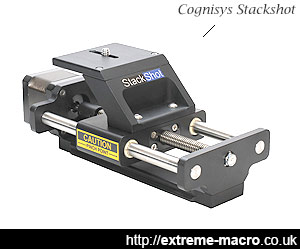Extreme Macro Equipment
by Johan J Ingles-Le Nobel
Last updated August 31, 2017
Beyond extreme macro lenses which are covered in their own section, extreme macro involves the use of a lot of other (sadly usually expensive) specialised equipment.
It is not only often difficult to know what is necessary and what is nice to have, but also there are certain things that make life easier that you will only discover with the experience of actually going out and buying them, and are all covered in the extreme macro equipment section of the site. Lenses are here.
Extreme Macro Stages
The largest category of extreme macro equipment other than lenses is stages of various types. 'Stages' not only includes a stage to move your camera, but also to move your specimen. At its most basic, a good stage to move your specimen might be a simple lab lifter and a Velbon stage, whilst at its most advanced you're looking at a Stackshot Stacker with a universal stage.
you'll want to know what to look for in a decent set of bellowsIn addition, you'll want to know what to look for in a decent set of bellows, and you might want to consider butchering a microscope part to create the perfect vertical stage. The difference between good bellows and cheap eBay M42 bellows is vast.
Optical Accessories
There are all sorts of optical accessories that can make your life easier, from an eyepiece that lets you look into a camera sitting on the ground, to an iris that you can put near your lens to give a nice transition between the in focus areas and out of focus areas.
If you want an easy way to vary the distance between lens and sensor in the field without taking a bellows everywhere there's a way to do that, but if you want to buy a really handy macro tripod, there are certain specific features that you'll want to look for. Or you can make your own extreme macro photography beanbag.
there are often cheaper ways to achieve much the same resultsBeyond that there are also things like lens adapters, holding tools, field monitors and an HDMI matrix to switch screens which you may want to consider.
Many manufacturers seem to think that people buying camera equipment are made of money, and there are often cheaper ways to achieve much the same results.
Extreme Macro Studio Equipment
Stackshot, the ultimate convenience in extreme macro stacking, capable of 1µm steps in its high precision mode. The bottom is a standard dovetail connection and the top is a standard tripod thread. Stackshot does everything you need for stacking and a little bit more and although it is an expensive initial purchase costing the same as a reasonable lens I still wouldn't want to be without it.
Another category of equipment that the extreme macro photographer needs to contend with is studio equipment, covering everything from a micromanipulator to positioning lights. Stereo microscopes and to a lesser extend field microscopes come under this category as well, because they are a vital part of the workflow in preparing the specimen.
All the lighting components of the extreme macro studio are described and discussed under the lighting section, which includes mundane but necessary components such as diffuser clamps, flash clamps and PC-sync accessories.
There are also less glamorous but equally vital pieces of equipment that are used with regard to insects but these are covered in the insects section. This includes traps to catch insects, equipment to still insects and tools to mount and prepare insects.
Extreme Macro Software
Post Processing is the final key step in the image flowLast but certainly not least, the niche software used to make extreme macro images: from specialist stacking software like Zerene Stacker to software that lets you get the most detail out of your shots. Post Processing is the final key step in the image flow from shooting to presentation and can make or break an image and turn turds into diamonds. The post processing tools that you use will have a great deal of effect on what you're able to achieve.
Related Articles





